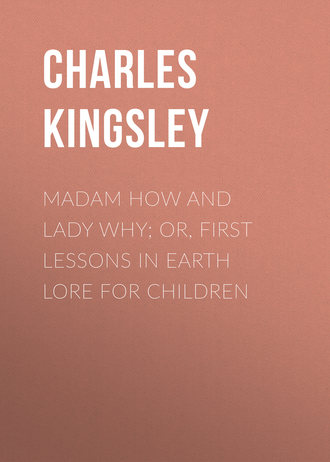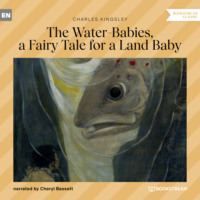 полная версия
полная версияMadam How and Lady Why; Or, First Lessons in Earth Lore for Children
Just because it is set on flat, not upright: and learned men will tell you that those two flukes are the “rudiments”—that is, either the beginning, or more likely the last remains—of two hind feet. But that belongs to the second volume of Madam How’s Book of Kind; and you have not yet learned any of the first volume, you know, except about a few butterflies. Look here! Here are more whales coming. Don’t be frightened. They are only little ones, mackerel-hunting, like the big one.
What pretty smooth things, turning head over heels, and saying, “Hush, Hush!”
They don’t really turn clean over; and that “Hush” is their way of breathing.
Are they the young ones of that great monster?
No; they are porpoises. That big one is, I believe, a bottle-nose. But if you want to know about the kinds of whales, you must ask Dr. Flower at the Royal College of Surgeons, and not me: and he will tell you wonderful things about them.—How some of them have mouths full of strong teeth, like these porpoises; and others, like the great sperm whale in the South Sea, have huge teeth in their lower jaws, and in the upper only holes into which those teeth fit; others like the bottle-nose, only two teeth or so in the lower jaw; and others, like the narwhal, two straight tusks in the upper jaw, only one of which grows, and is what you call a narwhal’s horn.
Oh yes. I know of a walking-stick made of one.
And strangest of all, how the right-whales have a few little teeth when they are born, which never come through the gums; but, instead, they grow all along their gums, an enormous curtain of clotted hair, which serves as a net to keep in the tiny sea-animals on which they feed, and let the water strain out.
You mean whalebone? Is whalebone hair?
So it seems. And so is a rhinoceros’s horn. A rhinoceros used to be hairy all over in old times: but now he carries all his hair on the end of his nose, except a few bristles on his tail. And the right-whale, not to be done in oddity, carries all his on his gums.
But have no whales any hair?
No real whales: but the Manati, which is very nearly a whale, has long bristly hair left. Don’t you remember M.’s letter about the one he saw at Rio Janeiro?
This is all very funny: but what is the use of knowing so much about things’ teeth and hair?
What is the use of learning Latin and Greek, and a dozen things more which you have to learn? You don’t know yet: but wiser people than you tell you that they will be of use some day. And I can tell you, that if you would only study that gar-fish long enough, and compare him with another fish something like him, who has a long beak to his lower jaw, and none to his upper—and how he eats I cannot guess,—and both of them again with certain fishes like them, which M. Agassiz has found lately, not in the sea, but in the river Amazon; and then think carefully enough over their bones and teeth, and their history from the time they are hatched—why, you would find out, I believe, a story about the river Amazon itself, more wonderful than all the fairy tales you ever read.
Now there is luncheon ready. Come down below, and don’t tumble down the companion-stairs; and by the time you have eaten your dinner we shall be very near the shore.
* * * * *So? Here is my little man on deck, after a good night’s rest. And he has not been the least sick, I hear.
Not a bit: but the cabin was so stuffy and hot, I asked leave to come on deck. What a huge steamer! But I do not like it as well as the yacht. It smells of oil and steam, and—
And pigs and bullocks too, I am sorry to say. Don’t go forward above them, but stay here with me, and look round.
Where are we now? What are those high hills, far away to the left, above the lowlands and woods?
Those are the shore of the Old World—the Welsh mountains.
And in front of us I can see nothing but flat land. Where is that?
That is the mouth of the Severn and Avon; where we shall be in half an hour more.
And there, on the right, over the low hills, I can see higher ones, blue and hazy.
Those are an island of the Old World, called now the Mendip Hills; and we are steaming along the great strait between the Mendips and the Welsh mountains, which once was coral reef, and is now the Severn sea; and by the time you have eaten your breakfast we shall steam in through a crack in that coral-reef; and you will see what you missed seeing when you went to Ireland, because you went on board at night.
* * * * *Oh! Where have we got to now? Where is the wide Severn Sea?
Two or three miles beyond us; and here we are in narrow little Avon.
Narrow indeed. I wonder that the steamer does not run against those rocks. But how beautiful they are, and how the trees hang down over the water, and are all reflected in it!
Yes. The gorge of the Avon is always lovely. I saw it first when I was a little boy like you; and I have seen it many a time since, in sunshine and in storm, and thought it more lovely every time. Look! there is something curious.
What? Those great rusty rings fixed into the rock?
Yes. Those may be as old, for aught I know, as Queen Elizabeth’s or James’s reign.
But why were they put there?
For ships to hold on by, if they lost the tide.
What do you mean?
It is high tide now. That is why the water is almost up to the branches of the trees. But when the tide turns, it will all rush out in a torrent which would sweep ships out to sea again, if they had not steam, as we have, to help them up against the stream. So sailing ships, in old times, fastened themselves to those rings, and rode against the stream till the tide turned, and carried them up to Bristol.
But what is the tide? And why does it go up and down? And why does it alter with the moon, as I heard you all saying so often in Ireland?
That is a long story, which I must tell you something about some other time. Now I want you to look at something else: and that is, the rocks themselves, in which the rings are. They are very curious in my eyes, and very valuable; for they taught me a lesson in geology when I was quite a boy: and I want them to teach it to you now.
What is there curious in them?
This. You will soon see for yourself, even from the steamer’s deck, that they are not the same rock as the high limestone hills above. They are made up of red sand and pebbles; and they are a whole world younger, indeed some say two worlds younger, than the limestone hills above, and lie upon the top of the limestone. Now you may see what I meant when I said that the newer rocks, though they lie on the top of the older, were often lower down than they are.
But how do you know that they lie on the limestone?
Look into that corner of the river, as we turn round, and you will see with your own eyes. There are the sandstones, lying flat on the turned-up edges of another rock.
Yes; I see. The layers of it are almost upright.
Then that upright rock underneath is part of the great limestone hill above. So the hill must have been raised out of the sea, ages ago, and eaten back by the waves; and then the sand and pebbles made a beach at its foot, and hardened into stone; and there it is. And when you get through the limestone hills to Bristol, you will see more of these same red sandstone rocks, spread about at the foot of the limestone-hills, on the other side.
But why is the sandstone two worlds newer than the limestone?
Because between that sandstone and that limestone come hundreds of feet of rock, which carry in them all the coal in England. Don’t you remember that I told you that once before?
Oh yes. But I see no coal between them there.
No. But there is plenty of coal between them over in Wales; and plenty too between them on the other side of Bristol. What you are looking at there is just the lip of a great coal-box, where the bottom and the lid join. The bottom is the mountain limestone; and the lid is the new red sandstone, or Trias, as they call it now: but the coal you cannot see. It is stowed inside the box, miles away from here. But now, look at the cliffs and the downs, which (they tell me) are just like the downs in the Holy Land; and the woods and villas, high over your head.
And what is that in the air? A bridge?
Yes—that is the famous Suspension Bridge—and a beautiful work of art it is. Ay, stare at it, and wonder at it, little man, of course.
But is it not wonderful?
Yes: it was a clever trick to get those chains across the gulf, high up in the air: but not so clever a trick as to make a single stone of which those piers are built, or a single flower or leaf in those woods. The more you see of Madam How’s masonry and carpentry, the clumsier man’s work will look to you. But now we must get ready to give up our tickets, and go ashore, and settle ourselves in the train; and then we shall have plenty to see as we run home; more curious, to my mind, than any suspension bridge.
And you promised to show me all the different rocks and soils as we went home, because it was so dark when we came from Reading.
Very good.
* * * * *Now we are settled in the train. And what do you want to know first?
More about the new rocks being lower than the old ones, though they lie on the top of them.
Well, look here, at this sketch.
A boy piling up slates? What has that to do with it?
I saw you in Ireland piling slates against a rock just in this way. And I thought to myself—“That is something like Madam How’s work.”
How?
Why, see. The old rock stands for the mountains of the Old World, like the Welsh mountains, or the Mendip Hills. The slates stand for the new rocks, which have been piled up against these, one over the other. But, you see, each slate is lower than the one before it, and slopes more; till the last slate which you are putting on is the lowest of all, though it overlies all.
I see now. I see now.
Then look at the sketch of the rocks between this and home. It is only a rough sketch, of course: but it will make you understand something more about the matter. Now. You see, the lump marked A. With twisted lines in it. That stands for the Mendip Hills to the west, which are made of old red sandstone, very much the same rock (to speak roughly) as the Kerry mountains.
And why are the lines in it twisted?
To show that the strata, the layers in it, are twisted, and set up at quite different angles from the limestone.
But how was that done?
By old earthquakes and changes which happened in old worlds, ages on ages since. Then the edges of the old red sandstone were eaten away by the sea—and some think by ice too, in some earlier age of ice; and then the limestone coral reef was laid down on them, “unconformably,” as geologists say—just as you saw the new red sandstone laid down on the edges of the limestone; and so one world is built up on the edge of another world, out of its scraps and ruins.
Then do you see B. With a notch in it? That means these limestone hills on the shoulder of the Mendips; and that notch is the gorge of the Avon which we have steamed through.
And what is that black above it?
That is the coal, a few miles off, marked C.
And what is this D, which comes next?
That is what we are on now. New red sandstone, lying unconformably on the coal. I showed it you in the bed of the river, as we came along in the cab. We are here in a sort of amphitheatre, or half a one, with the limestone hills around us, and the new red sandstone plastered on, as it were, round the bottom of it inside.
But what is this high bit with E against it?
Those are the high hills round Bath, which we shall run through soon. They are newer than the soil here; and they are (for an exception) higher too; for they are so much harder than the soil here, that the sea has not eaten them away, as it has all the lowlands from Bristol right into the Somersetshire flats.
* * * * *There. We are off at last, and going to run home to Reading, through one of the loveliest lines (as I think) of old England. And between the intervals of eating fruit, we will geologize on the way home, with this little bit of paper to show us where we are.
What pretty rocks!
Yes. They are a boss of the coal measures, I believe, shoved up with the lias, the lias lying round them. But I warn you I may not be quite right: because I never looked at a geological map of this part of the line, and have learnt what I know, just as I want you to learn simply by looking out of the carriage window.
Look. Here is lias rock in the side of the cutting; layers of hard blue limestone, and then layers of blue mud between them, in which, if you could stop to look, you would find fossils in plenty; and along that lias we shall run to Bath, and then all the rocks will change.
* * * * *Now, here we are at Bath; and here are the handsome fruit-women, waiting for you to buy.
And oh, what strawberries and cherries!
Yes. All this valley is very rich, and very sheltered too, and very warm; for the soft south-western air sweeps up it from the Bristol Channel; so the slopes are covered with fruit-orchards, as you will see as you get out of the station.
Why, we are above the tops of the houses.
Yes. We have been rising ever since we left Bristol; and you will soon see why. Now we have laid in as much fruit as is safe for you, and away we go.
Oh, what high hills over the town! And what beautiful stone houses! Even the cottages are built of stone.
All that stone comes out of those high hills, into which we are going now. It is called Bath-stone freestone, or oolite; and it lies on the top of the lias, which we have just left. Here it is marked F.
What steep hills, and cliffs too, and with quarries in them! What can have made them so steep? And what can have made this little narrow valley?
Madam How’s rain-spade from above, I suppose, and perhaps the sea gnawing at their feet below. Those freestone hills once stretched high over our heads, and far away, I suppose, to the westward. Now they are all gnawed out into cliffs,—indeed gnawed clean through in the bottom of the valley, where the famous hot springs break out in which people bathe.
Is that why the place is called Bath?
Of course. But the Old Romans called the place Aquæ Solis—the waters of the sun; and curious old Roman remains are found here, which we have not time to stop and see.
Now look out at the pretty clear limestone stream running to meet us below, and the great limestone hills closing over us above. How do you think we shall get out from among them?
Shall we go over their tops?
No. That would be too steep a climb, for even such a great engine as this.
Then there is a crack which we can get through?
Look and see.
Why, we are coming to a regular wall of hill, and—
And going right through it in the dark. We are in the Box Tunnel.
* * * * *There is the light again: and now I suppose you will find your tongue.
How long it seemed before we came out!
Yes, because you were waiting and watching, with nothing to look at: but the tunnel is only a mile and a quarter long after all, I believe. If you had been looking at fields and hedgerows all the while, you would have thought no time at all had passed.
What curious sandy rocks on each side of the cutting, in lines and layers.
Those are the freestone still: and full of fossils they are. But do you see that they dip away from us? Remember that. All the rocks are sloping eastward, the way we are going; and each new rock or soil we come to lies on the top of the one before it. Now we shall run down hill for many a mile, down the back of the oolites, past pretty Chippenham, and Wootton-Bassett, towards Swindon spire. Look at the country, child; and thank God for this fair English land, in which your lot is cast.
What beautiful green fields; and such huge elm trees; and orchards; and flowers in the cottage gardens!
Ay, and what crops, too: what wheat and beans, turnips and mangold. All this land is very rich and easily worked; and hereabouts is some of the best farming in England. The Agricultural College at Cirencester, of which you have so often heard, lies thereaway, a few miles to our left; and there lads go to learn to farm as no men in the world, save English and Scotch, know how to farm.
But what rock are we on now?
On rock that is much softer than that on the other side of the oolite hills: much softer, because it is much newer. We have got off the oolites on to what is called the Oxford clay; and then, I believe, on to the Coral rag, and on that again lies what we are coming to now. Do you see the red sand in that field?
Then that is the lowest layer of a fresh world, so to speak; a world still younger than the oolites—the chalk world.
But that is not chalk, or anything like it.
No, that is what is called Greensand.
But it is not green, it is red.
I know: but years ago it got the name from one green vein in it, in which the “Coprolites,” as you learnt to call them at Cambridge, are found; and that, and a little layer of blue clay, called gault, between the upper Greensand and lower Greensand, runs along everywhere at the foot of the chalk hills.
I see the hills now. Are they chalk?
Yes, chalk they are: so we may begin to feel near home now. See how they range away to the south toward Devizes, and Westbury, and Warminster, a goodly land and large. At their feet, everywhere, run the rich pastures on which the Wiltshire cheese is made; and here and there, as at Westbury, there is good iron-ore in the greensand, which is being smelted now, as it used to be in the Weald of Surrey and Kent ages since. I must tell you about that some other time.
But are there Coprolites here?
I believe there are: I know there are some at Swindon; and I do not see why they should not be found, here and there, all the way along the foot of the downs, from here to Cambridge.
But do these downs go to Cambridge?
Of course they do. We are now in the great valley which runs right across England from south-west to north-east, from Axminster in Devonshire to Hunstanton in Norfolk, with the chalk always on your right hand, and the oolite hills on your left, till it ends by sinking into the sea, among the fens of Lincolnshire and Norfolk.
But what made that great valley?
I am not learned enough to tell. Only this I think we can say—that once on a time these chalk downs on our right reached high over our heads here, and far to the north; and that Madam How pared them away, whether by icebergs, or by sea-waves, or merely by rain, I cannot tell.
Well, those downs do look very like sea-cliffs.
So they do, very like an old shore-line. Be that as it may, after the chalk was eaten away, Madam How began digging into the soils below the chalk, on which we are now; and because they were mostly soft clays, she cut them out very easily, till she came down, or nearly down, to the harder freestone rocks which run along on our left hand, miles away; and so she scooped out this great vale, which we call here the Vale of White Horse; and further on, the Vale of Aylesbury; and then the Bedford Level; and then the dear ugly old Fens.
Is this the Vale of White Horse? Oh, I know about it; I have read The Scouring of the White Horse.
Of course you have; and when you are older you will read a jollier book still,—Tom Brown’s School Days—and when we have passed Swindon, we shall see some of the very places described in it, close on our right.
* * * * *There is the White Horse Hill.
The White Horse Hill? But where is the horse? I can see a bit of him: but he does not look like a horse from here, or indeed from any other place; he is a very old horse indeed, and a thousand years of wind and rain have spoilt his anatomy a good deal on the top of that wild down.
And is that really where Alfred fought the Danes?
As certainly, boy, I believe, as that Waterloo is where the Duke fought Napoleon. Yes: you may well stare at it with all your eyes, the noble down. It is one of the most sacred spots on English soil.
Ah, it is gone now. The train runs so fast.
So it does; too fast to let you look long at one thing: but in return, it lets you see so many more things in a given time than the slow old coaches and posters did.—Well? what is it?
I wanted to ask you a question, but you won’t listen to me.
Won’t I? I suppose I was dreaming with my eyes open. You see, I have been so often along this line—and through this country, too, long before the line was made—that I cannot pass it without its seeming full of memories—perhaps of ghosts.
Of real ghosts?
As real ghosts, I suspect, as any one on earth ever saw; faces and scenes which have printed themselves so deeply on one’s brain, that when one passes the same place, long years after, they start up again, out of fields and roadsides, as if they were alive once more, and need sound sense to send them back again into their place as things which are past for ever, for good and ill. But what did you want to know?
Why, I am so tired of looking out of the window. It is all the same: fields and hedges, hedges and fields; and I want to talk.
Fields and hedges, hedges and fields? Peace and plenty, plenty and peace. However, it may seem dull, now that the grass is cut; but you would not have said so two months ago, when the fields were all golden-green with buttercups, and the whitethorn hedges like crested waves of snow. I should like to take a foreigner down the Vale of Berkshire in the end of May, and ask him what he thought of old England. But what shall we talk about?
I want to know about Coprolites, if they dig them here, as they do at Cambridge.
I don’t think they do. But I suspect they will some day.
But why do people dig them?
Because they are rational men, and want manure for their fields.
But what are Coprolites?
Well, they were called Coprolites at first because some folk fancied they were the leavings of fossil animals, such as you may really find in the lias at Lynn in Dorsetshire. But they are not that; and all we can say is, that a long time ago, before the chalk began to be made, there was a shallow sea in England, the shore of which was so covered with dead animals, that the bone-earth (the phosphate of lime) out of them crusted itself round every bone, and shell, and dead sea-beast on the shore, and got covered up with fresh sand, and buried for ages as a mine of wealth.
But how many millions of dead creatures, there must have been! What killed them?
We do not know. No more do we know how it comes to pass that this thin band (often only a few inches thick) of dead creatures should stretch all the way from Dorsetshire to Norfolk, and, I believe, up through Lincolnshire. And what is stranger still, this same bone-earth bed crops out on the south side of the chalk at Farnham, and stretches along the foot of those downs, right into Kent, making the richest hop lands in England, through Surrey, and away to Tunbridge. So that it seems as if the bed lay under the chalk everywhere, if once we could get down to it.
But how does it make the hop lands so rich?
Because hops, like tobacco and vines, take more phosphorus out of the soil than any other plants which we grow in England; and it is the washings of this bone-earth bed which make the lower lands in Farnham so unusually rich, that in some of them—the garden, for instance, under the Bishop’s castle—have grown hops without resting, I believe, for three hundred years.
But who found out all this about the Coprolites?
Ah—I will tell you; and show you how scientific men, whom ignorant people sometimes laugh at as dreamers, and mere pickers up of useless weeds and old stones, may do real service to their country and their countrymen, as I hope you will some day.
There was a clergyman named Henslow, now with God, honoured by all scientific men, a kind friend and teacher of mine, loved by every little child in his parish. His calling was botany: but he knew something of geology. And some of these Coprolites were brought him as curiosities, because they had fossils in them. But he (so the tale goes) had the wit to see that they were not, like other fossils, carbonate of lime, but phosphate of lime—bone earth. Whereon he told the neighbouring farmers that they had a mine of wealth opened to them, if they would but use them for manure. And after a while he was listened to. Then others began to find them in the Eastern counties; and then another man, as learned and wise as he was good and noble—John Paine of Farnham, also now with God—found them on his own estate, and made much use and much money of them: and now tens of thousands of pounds’ worth of valuable manure are made out of them every year, in Cambridgeshire and Bedfordshire, by digging them out of land which was till lately only used for common farmers’ crops.











